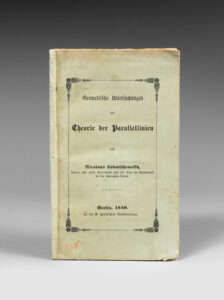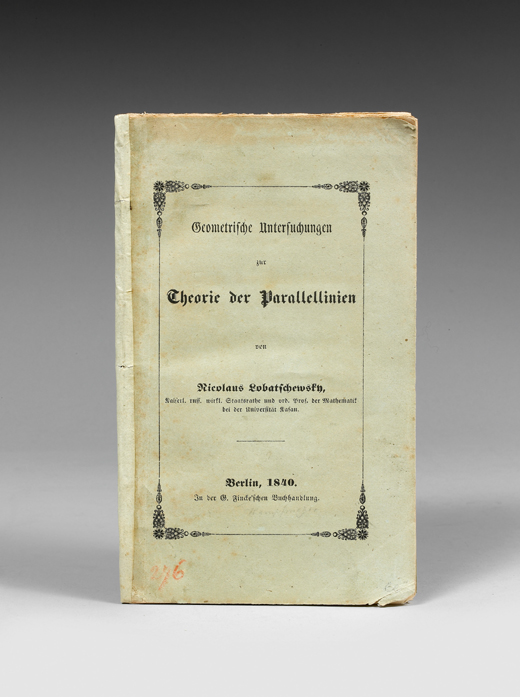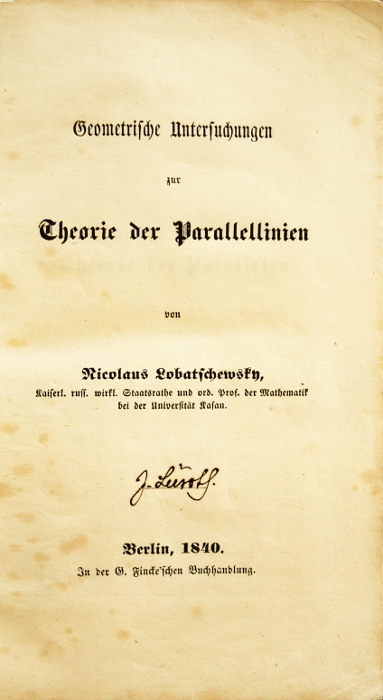LOBACHEVSKI, Nicolai Ivanovitch. Geometrische Untersuchungen zur Theorie der Parallellinien. Berlin, G. Fincke, 1840.
In-8 de (1) f. de titre, 61 pp., (1) p., 2 planches dépliantes. Quelques piqûres. Conservé dans sa brochure verte imprimée d’origine. Petit manque à l’angle inférieur droit, plat inférieur renouvelé.
188 x 113 mm.
Rare édition originale de ce texte fondateur de la géométrie non-euclidienne, par le «copernicus of geometry » (PMM). PMM 293; Poggendorff I, 1482; Engel 13; DSB VIII, 432 f.; Norman I, 1379.
La géométrie non-euclidienne eut deux découvreurs indépendants : Johann Bolyai (1802-1860), un officier Hongrois de l’armée autrichienne et Nicolai Lobachevski (1793-1856), le fils d’un paysan russe, professeur et recteur de l’Université de Kazan.
Tous deux créèrent des systèmes géométriques non-euclidiens en remettant en question le « postulat des parallèles » d’Euclide.
Le premier fruit de ces nouvelles études d’une géométrie non-euclidienne est un papier qui fut lu par Lobachevski devant la section physico-mathématique de l’Université de Kazan en février 1826. Ce texte ne semble pas avoir été préservé, mais ses principales idées sont contenues dans un mémoire publié en 1829-1830 dans un périodique de l’Université de Kazan, mémoire qui fut en fait le premier texte sur le sujet à être imprimé.
Lobachevski s’efforça d’attirer l’attention des mathématiciens sur ses découvertes en publiant un résumé plus accessible de ses résultats dans un petit ouvrage imprimé à Berlin en 1840 sous le titre de : Geometrische Untersuchungen zur Theorie der Parallellinien. Cette dernière publication impressionna fortement Gauss.
« Gauss who had received a copy of the ‘Geometrische Untersuchungen’ from Lobachevsky, spoke to him flatteringly of the book, studied Russian especially to read his work in their original language, and supported his election to the Göttingen Gesellschaft der Wissenschaften” (DSB).
« The revolution in our conception of the nature of mathematics can be traced back to the explicit formulation of the first non-Euclidian geometries early in the nineteenth century. The researches that culminated in the discovery of non-Euclidean geometry arose from unsuccessful attempts to prove the axiom of parallels in Euclidean geometry. This postulate asserts that through any point there can be drawn one and only one straight line parallel to a given straight line. Although this statement was not regarded as self-evident and its derivation from the other axioms of geometry was repeatedly sought, no one openly challenged it as an accepted truth of the universe until Lobatchewsky published the first non-Euclidean geometry […]. In Lobatchewsky’s geometry an infinity of parallels can be drawn through a given point that never intersect a given straight line.Nicolai Ivanovitch Lobatchewsky was born in Nizhni-Novgorod, Russia, and studied at the University of Kazan, where in 1827 he was appointed professor. His fundamental paper was read to his colleagues in Kazan in 1826 but he did not publish the results until 1829-30 when a series of five papers appeared in the Kazan University Courier, the first of which bore the title cited above, ‘The Origins of Geometry’. He amplified his findings (still in Russian) in 1836-8 under the title ‘New Elements of Geometry, with a Complete Theory of Parallels’. In 1840 he published a brief summary in Berlin under the title Geometrische Untersuchungen zur Theorie der Parallellinien”. (PMM).



